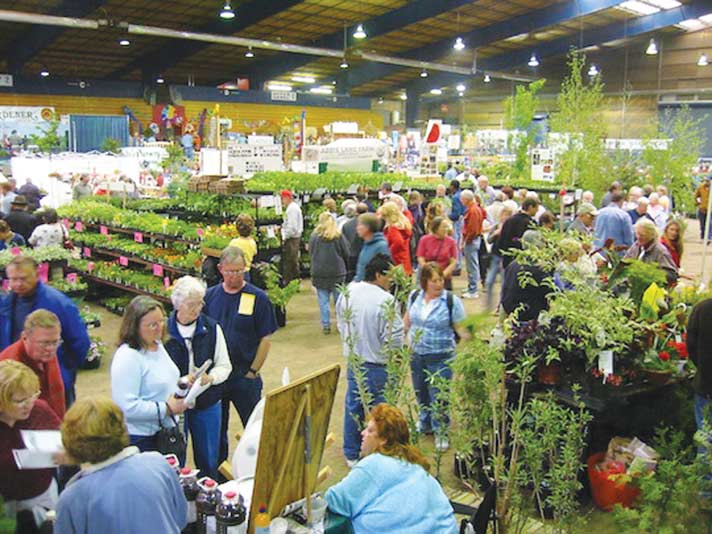The Literary Gardener – May 2015
“If the English language made any sense, ‘lackadaisical’ would have something to do with a shortage of flowers.” ~Doug Larson, columnist
My English Composition students are often overwhelmed by the word choices they face when they write an essay. It’s the same with me, as a gardener. When I pour over a plant catalog or visit a garden nursery, I sometimes become dizzy with the array of colorful choices laid out before me. It’s all too easy to either throw up my hands in frustration, or spend money on plants that may not be the best selections for my garden.
I need to heed the advice I give to writing students: What do you ultimately want to accomplish? Once that’s figured out, writers, and gardeners, can make informed decisions that will appeal to their “audience” and help them achieve their goals.
An important purpose for my gardening this year is to attract an active audience of beneficial insects to my flowers and herbs. Such welcome visitors include bees and butterflies that not only serve as pollinators, but also add color in motion. As American novelist Robert Heinlein wrote, “Butterflies are self-propelled flowers.” And Ray Bradbury said, “Bees…their feet are dusted with spices from a million flowers.”
I’m going to practice what I teach when I attend the Jackson County Master Gardener’s 36th Annual Spring Garden Fair this weekend, May 2 and 3, at the Expo in Central Point. With more than 150 booths and exhibits, as well as thousands of ornamental and edible plants, I need a plan!
Fortunately, Master Gardeners have put together a listing of plants available at the JCMG booths this year that shows which offerings are most enticing to the winged guests on my invite list. Of course, I also need to keep in mind the amount of sun the plants will need in order to thrive. My beds have full sun exposure (at least 8 hours), so here’s what I’ve come up with to attract butterflies and bees to my garden:
Edibles—chives, garlic, oregano, thyme, and mint. Also, bees adore yellow, green, and red peppers, but butterflies are more coy.
Annual flowers—calendula, cosmos, marigolds, and zinnias
Perennials—yarrow, larkspur, Shasta daisies, and milkweed. Dahlias, which are tuberous root plants and do best in sun with afternoon shade, are also on my list because they’re magnets for butterflies, specifically.
As an added bonus for my garden, many of these same plants attract other beneficial insects. Cosmos, for example, draw lacewings and ladybugs, both of which feed on aphids, mealybugs, and mites. Cosmos, marigolds, and spearmint appeal to spiders; if you are not arachnophobic, you’ll love them for their diet consisting of many garden insect pests.
Why are pollinators attracted to specific plants? Flowering plants have adapted colors, scents, and shapes that assist them in continuing their species. Cosmos, with their irresistible smell of nectar, draw bees and butterflies (as well as hummingbirds). Flowers we see as yellowish–calendula, marigolds–appear blue to bees, a color they apparently think is sexy in the same way we associate passion with red. Broad flower heads, like that of yarrow, serve as handy landing pads for insects. In the case of milkweed, while toxic to humans and pets, Monarch butterflies know it’s the only plant their caterpillar offspring will eat.
I always tell my students that planning before they write is time well spent; likewise, it’s been worthwhile to plan ahead for my Spring Garden Fair experience. Although I may stray a bit once I get there, my goal is to stay focused on plants that will bring as many bees and butterflies to my garden as possible. I’ll take the advice offered by French author Antoine de Saint-Exupery: “A goal without a plan is just a wish.”
For more plant listings, check the Spring Garden Fair page on the Jackson County Master Gardener website at: www.jacksoncounty.mga.org.

 Rhonda Nowak is a teacher, writer and gardener who lives and works in the Rogue Valley. She has taught literature and language arts for 25 years, the last six at Rogue Community College. In addition to her column for the Jacksonville Review, she writes a weekly column and blog called the Literary Gardener for the Mail Tribune. She also writes articles for Southern Oregon Wine Scene magazine and is writer and editor of Ashland Living magazine. Email Rhonda at Rnowak39@gmail.com.
Read more on her blog at
Rhonda Nowak is a teacher, writer and gardener who lives and works in the Rogue Valley. She has taught literature and language arts for 25 years, the last six at Rogue Community College. In addition to her column for the Jacksonville Review, she writes a weekly column and blog called the Literary Gardener for the Mail Tribune. She also writes articles for Southern Oregon Wine Scene magazine and is writer and editor of Ashland Living magazine. Email Rhonda at Rnowak39@gmail.com.
Read more on her blog at